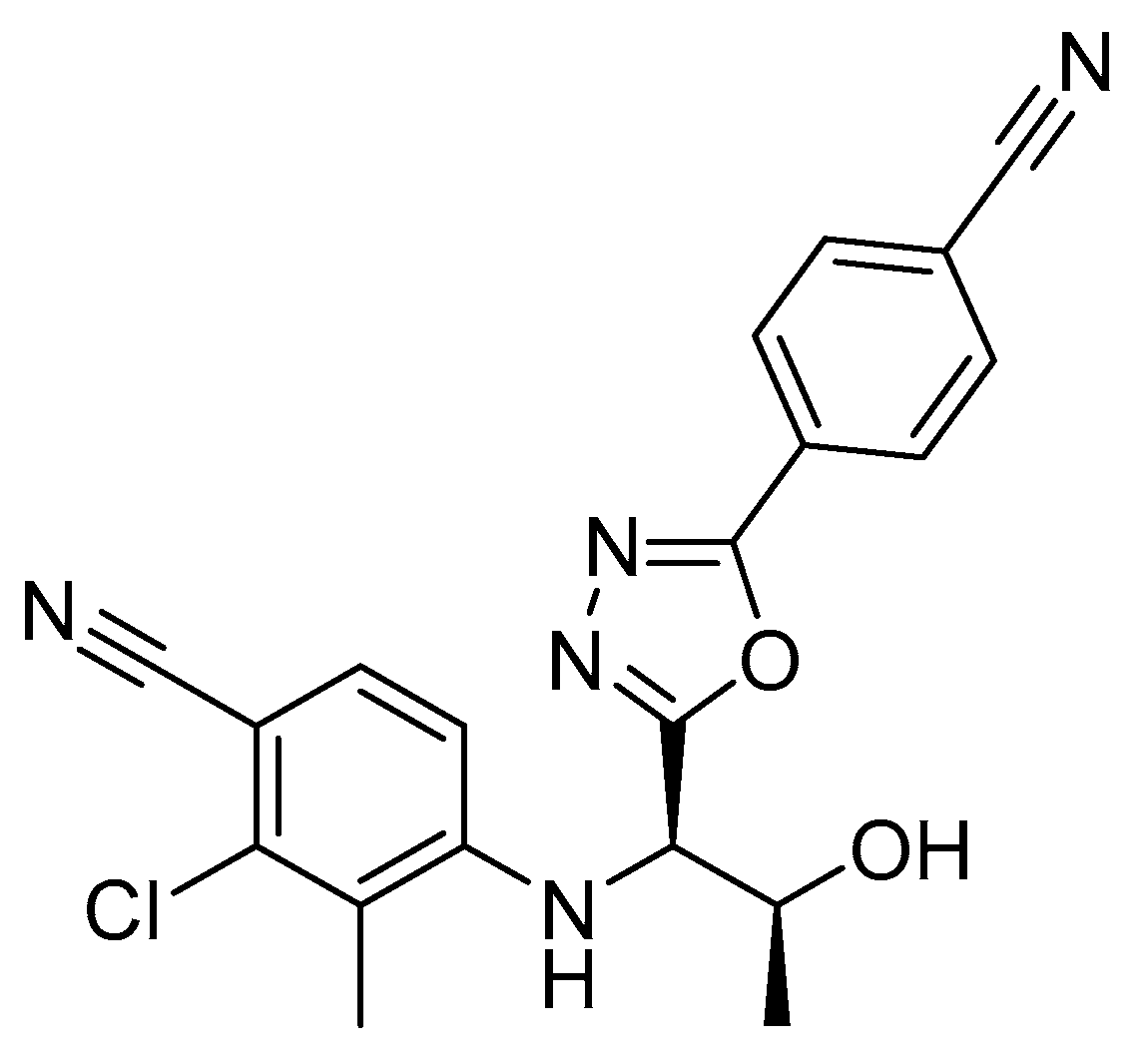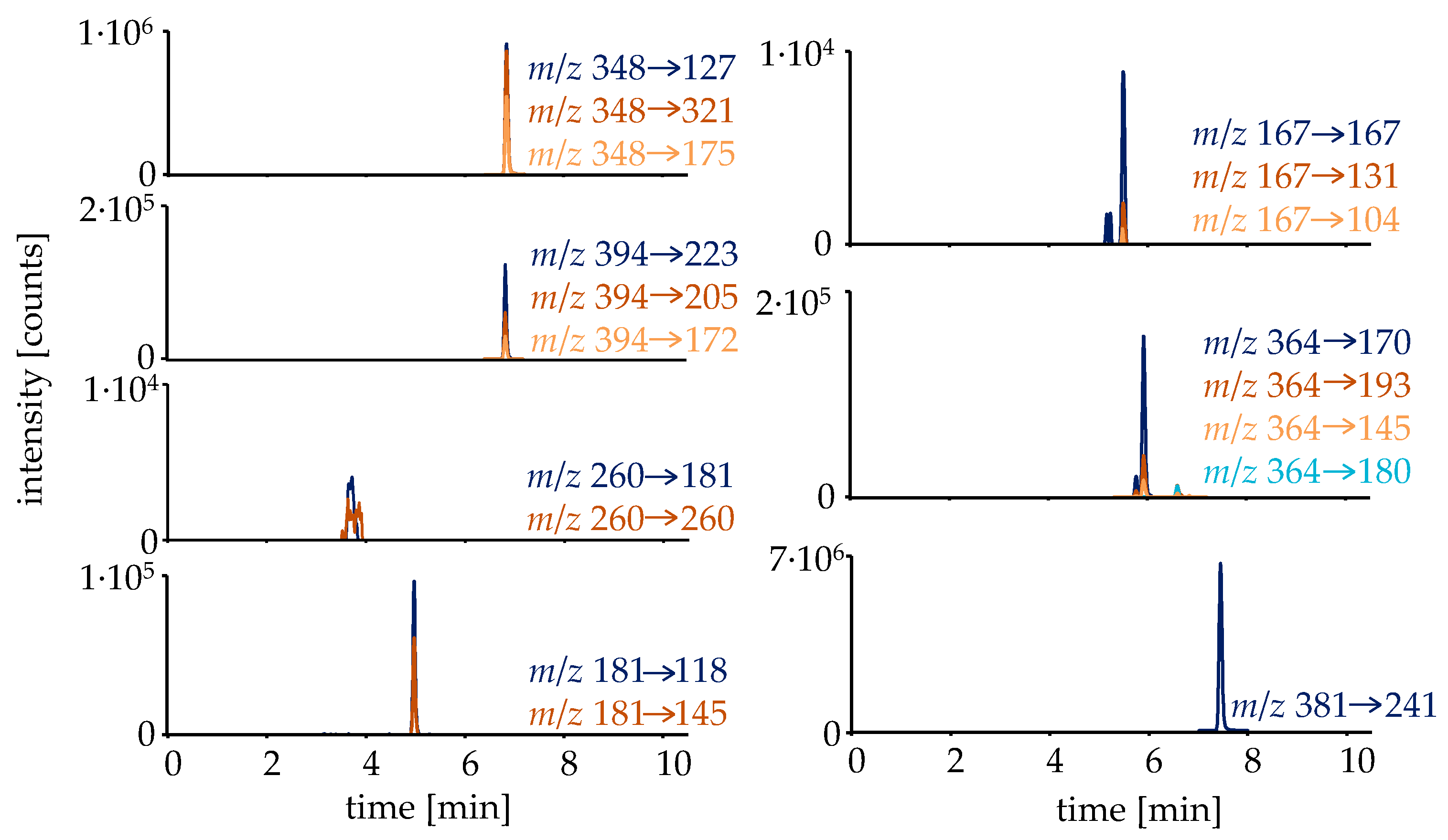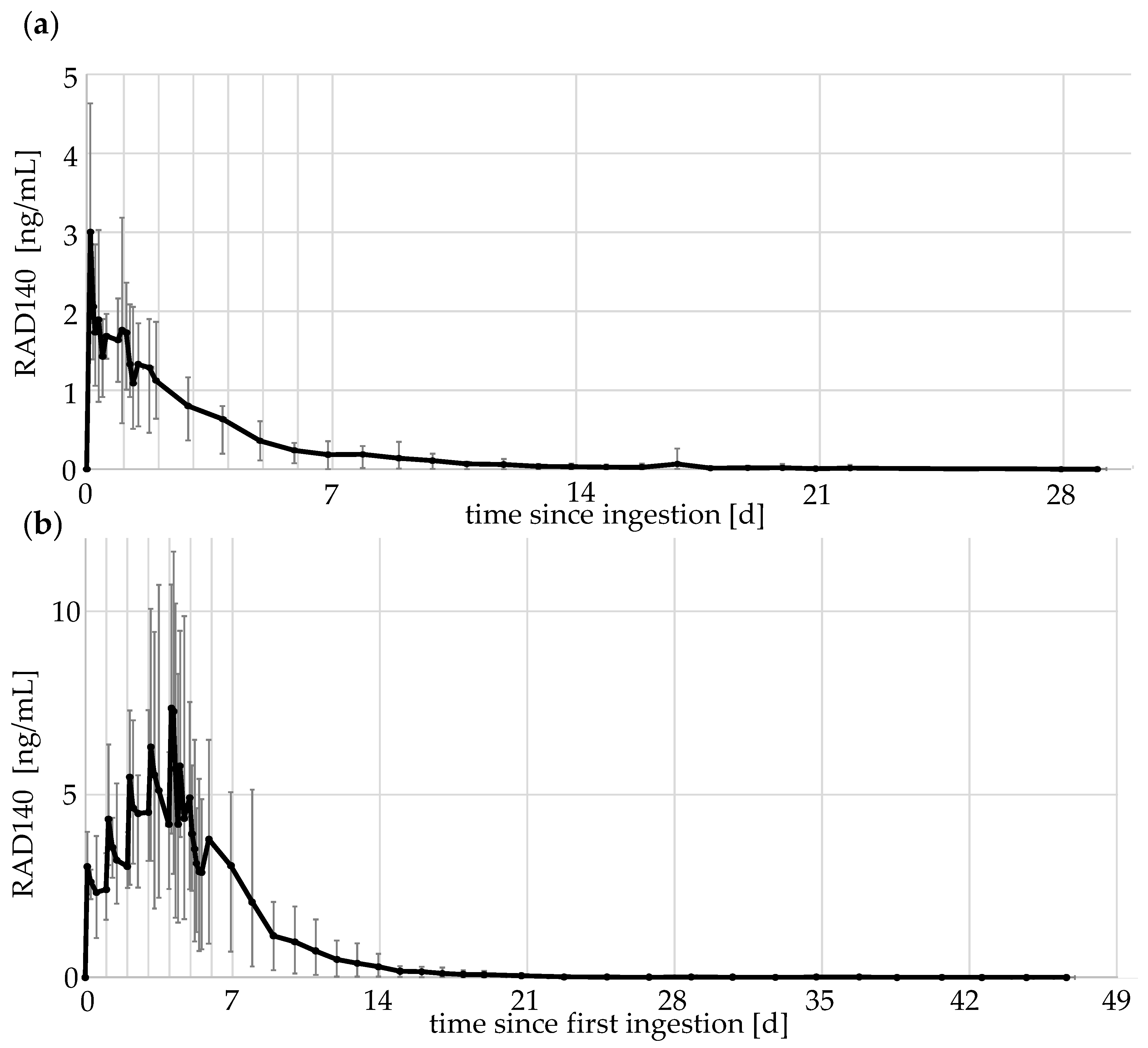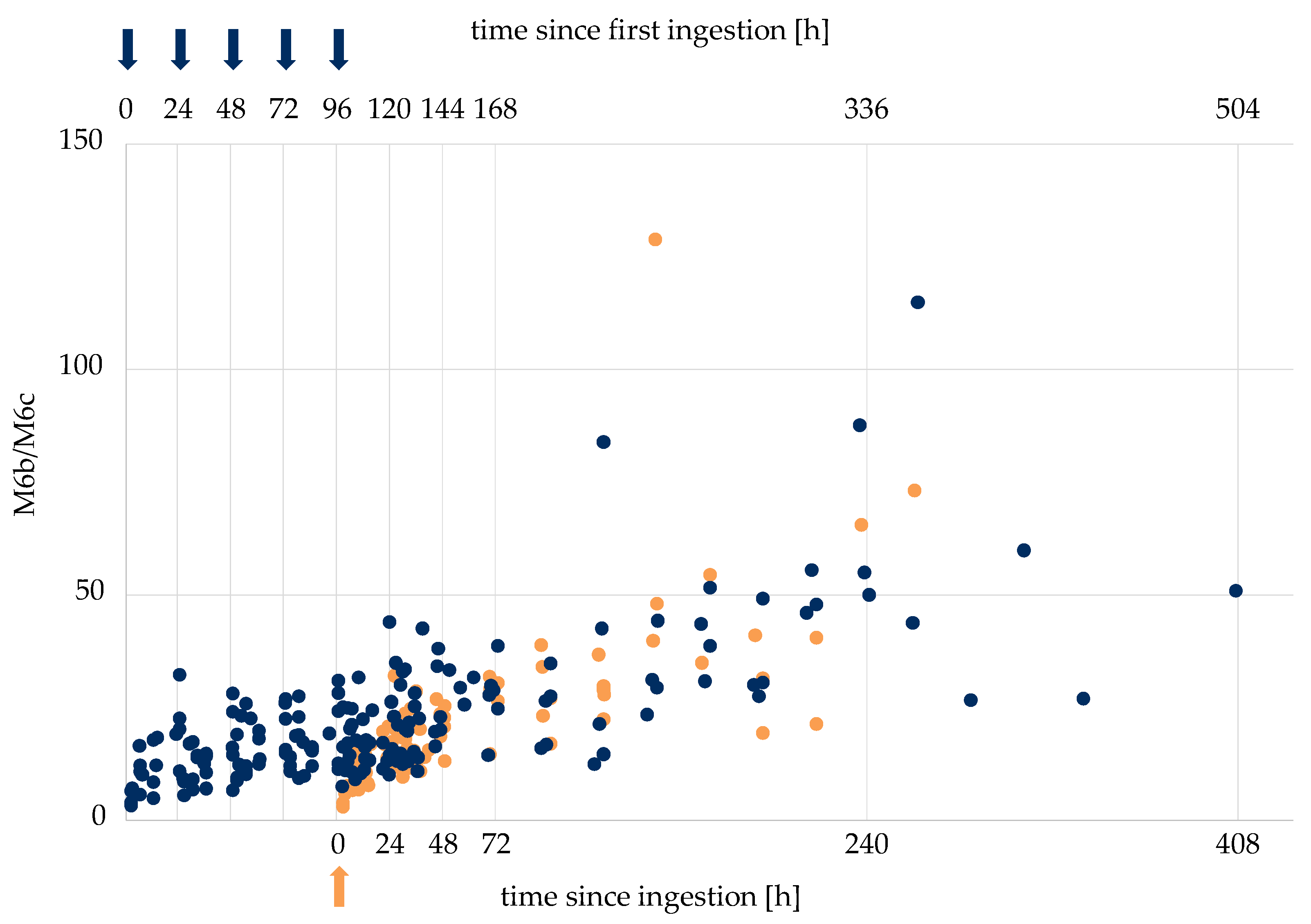Human In Vivo Metabolism and Elimination Behavior of Micro-Dosed Selective Androgen Receptor Modulator RAD140 for Doping Control Purposes
Abstract
:1. Introduction
2. Results and Discussion
2.1. Determination of Urinary Metabolites of RAD140
2.2. Method Characterization for the Detection of RAD140
2.3. Elimination Data of Micro-Dose Studies of RAD140
2.4. Metabolite Ratios of RAD140
3. Materials and Methods
3.1. Chemicals and Reagents
3.2. Sample Collection
3.3. Sample Preparation
3.4. Liquid Chromatography–High-Resolution Tandem Mass Spectrometry
3.5. Method Characterization
3.6. Biotransformer
4. Conclusions
Supplementary Materials
Author Contributions
Funding
Institutional Review Board Statement
Informed Consent Statement
Data Availability Statement
Conflicts of Interest
References
- Narayanan, R.; Coss, C.C.; Dalton, J.T. Development of selective androgen receptor modulators (sarms). Mol. Cell. Endocrinol. 2018, 465, 134–142. [Google Scholar] [CrossRef] [PubMed] [Green Version]
- Dalton, J.T.; Mukherjee, A.; Zhu, Z.; Kirkovsky, L.; Miller, D.D. Discovery of nonsteroidal androgens. Biochem. Biophys. Res. Commun. 1998, 244, 1–4. [Google Scholar] [CrossRef] [PubMed]
- Negro-Vilar, A. Selective androgen receptor modulators (sarms): A novel approach to androgen therapy for the new millennium. J. Clin. Endocrinol. Metab. 1999, 84, 3459–3462. [Google Scholar] [CrossRef] [PubMed]
- WADA. The 2008 Prohibited List. Available online: https://www.wada-ama.org/sites/default/files/resources/files/WADA_Prohibited_List_2008_EN.pdf (accessed on 12 July 2021).
- WADA. Prohibited List 2022. Available online: https://www.wada-ama.org/en/prohibited-list (accessed on 12 June 2022).
- Miller, C.P.; Shomali, M.; Lyttle, C.R.; O’Dea, L.S.L.; Herendeen, H.; Gallacher, K.; Paquin, D.; Compton, D.R.; Sahoo, B.; Kerrigan, S.A.; et al. Design, synthesis, and preclinical characterization of the selective androgen receptor modulator (sarm) rad140. ACS Med. Chem. Lett. 2011, 2, 124–129. [Google Scholar] [CrossRef] [PubMed] [Green Version]
- LoRusso, P.; Hamilton, E.; Ma, C.; Vidula, N.; Bagley, R.G.; Troy, S.; Annett, M.; Yu, Z.; Conlan, M.G.; Weise, A. A first-in-human phase 1 study of a novel selective androgen receptor modulator (sarm), rad140, in er+/her2- metastatic breast cancer. Clin. Breast Cancer 2022, 22, 67–77. [Google Scholar] [CrossRef] [PubMed]
- Padappayil, R.P.; Chandini Arjun, A.; Vivar Acosta, J.; Ghali, W.; Mughal, M.S. Acute myocarditis from the use of selective androgen receptor modulator (sarm) rad-140 (testolone). Cureus 2022, 14, e21663. [Google Scholar] [CrossRef]
- Barbara, M.; Dhingra, S.; Mindikoglu, A.L. Drug-induced liver injury associated with alpha bolic (rad-140) and alpha elite (rad-140 and lgd-4033). ACG Case Rep. J. 2020, 7, e00409. [Google Scholar] [CrossRef] [PubMed]
- Thevis, M.; Piper, T.; Beuck, S.; Geyer, H.; Schänzer, W. Expanding sports drug testing assays: Mass spectrometric characterization of the selective androgen receptor modulator drug candidates rad140 and acp-105. Rapid Commun. Mass Spectrom. 2013, 27, 1173–1182. [Google Scholar] [CrossRef] [PubMed]
- Sobolevsky, T.; Dikunets, M.; Rodchenkov, G. In vitro and in vivo metabolism of rad140, a novel non-steroidal sarm. Recent Adv. Doping Anal. 2013, 21, 121–124. [Google Scholar]
- So, Y.-M.; Wong, J.K.Y.; Choi, T.L.S.; Prabhu, A.; Stewart, B.; Farrington, A.F.; Robinson, P.; Wan, T.S.M.; Ho, E.N.M. Metabolic studies of selective androgen receptor modulators rad140 and s-23 in horses. Drug Test. Anal. 2021, 13, 318–337. [Google Scholar] [CrossRef] [PubMed]
- Martínez-Sanz, J.M.; Sospedra, I.; Ortiz, C.M.; Baladía, E.; Gil-Izquierdo, A.; Ortiz-Moncada, R. Intended or unintended doping? A review of the presence of doping substances in dietary supplements used in sports. Nutrients 2017, 9, 1093. [Google Scholar] [CrossRef] [PubMed] [Green Version]
- Thevis, M.; Kuuranne, T.; Fedoruk, M.; Geyer, H. Sports drug testing and the athletes’ exposome. Drug Test. Anal. 2021, 13, 1814–1821. [Google Scholar] [CrossRef] [PubMed]
- Walpurgis, K.; Thomas, A.; Geyer, H.; Mareck, U.; Thevis, M. Dietary supplement and food contaminations and their implications for doping controls. Foods 2020, 9, 1012. [Google Scholar] [CrossRef]
- WADA. World Anti-Doping Code 2021. Available online: https://www.wada-ama.org/en/resources/world-anti-doping-program/world-anti-doping-code (accessed on 13 June 2022).
- Walpurgis, K.; Rubio, A.; Wagener, F.; Krug, O.; Knoop, A.; Görgens, C.; Guddat, S.; Thevis, M. Elimination profiles of microdosed ostarine mimicking contaminated products ingestion. Drug Test. Anal. 2020, 12, 1570–1580. [Google Scholar] [CrossRef] [PubMed]
- Wagener, F.; Guddat, S.; Görgens, C.; Angelis, Y.S.; Petrou, M.; Lagojda, A.; Kühne, D.; Thevis, M. Investigations into the elimination profiles and metabolite ratios of micro-dosed selective androgen receptor modulator lgd-4033 for doping control purposes. Anal. Bioanal. Chem. 2021, 414, 1151–1162. [Google Scholar] [CrossRef] [PubMed]
- Djoumbou-Feunang, Y.; Fiamoncini, J.; Gil-de-la-Fuente, A.; Greiner, R.; Manach, C.; Wishart, D.S. Biotransformer: A comprehensive computational tool for small molecule metabolism prediction and metabolite identification. J. Cheminform. 2019, 11, 2. [Google Scholar] [CrossRef] [PubMed] [Green Version]
- Thevis, M.; Kamber, M.; Schänzer, W. Screening for metabolically stable aryl-propionamide-derived selective androgen receptor modulators for doping control purposes. Rapid Commun. Mass Spectrom. 2006, 20, 870–876. [Google Scholar] [CrossRef] [PubMed]
- WADA. International Standard for Laboratories 2021. Available online: https://www.wada-ama.org/en/resources/world-anti-doping-program/international-standard-laboratories-isl (accessed on 15 July 2022).
- WADA. Wada Technical Document—Minimum Criteria for Chromatographic-Mass Spectrometric Confirmation of the Identity of Analytes for Doping Control Purposes. Available online: https://www.wada-ama.org/en/resources/science-medicine/td2021idcr-0 (accessed on 24 June 2022).





| Analyte | Transformation | Molecular Formular | RT [min] | Polarity | Precursor Ions m/z | Product Ions m/z | NCE [%] | Ref. |
|---|---|---|---|---|---|---|---|---|
| RAD140 | - | C18H11ClN5O− | 6.84 | − | 348.0658 | 321.0549 127.0302 175.0068 | 20 | [11] |
| C20H17ClN5O2+ | + | 394.1065 | 223.0633 205.0527 172.0505 | 30 | [12] | |||
| M1 | hydrolysis hydroxylation sulfation | C8H6ClN2O4S− | 3.54 | − | 260.9742 | 181.0174 260.9742 | 25 | [12] |
| M2a | glucuronidation hydroxylation | C26H23ClN5O9− | 4.59 | − | 584.1190 | 193.0354 540.0928 364.0607 | 30 | |
| M2b | glucuronidation hydroxylation | 4.79 | − | 193.0354 390.0763 170.0360 | 30 | |||
| M3 | hydrolysis hydroxylation | C8H6ClN2O− | 4.98 | − | 181.0174 | 145.0407 118.0298 | 50 | [12] |
| M4 | glucuronidation | C26H23ClN5O8− | 5.42 | − | 568.1241 | 193.0354 113.0244 374.0814 | 30 | [12] |
| M5 | hydrolysis | C8H8ClN2+ | 5.49 | + | 167.0371 | 167.0371 131.0604 104.0495 | 50 | [12] |
| M6a | hydroxylation | C18H11ClN5O2− | 5.76 | − | 364.0607 | 170.0360 193.0174 145.0407 | 30 | [11] 1 |
| M6b | hydroxylation | 5.91 | − | 170.0360 193.0174 145.0407 | 30 | [11] 1 | ||
| M6c | hydroxylation | 6.59 | − | 180.0096 193.0174 145.0407 | 30 | [11] 1 | ||
| M7 | sulfation | C20H15ClN5O5S− | 6.25 | − | 472.0488 | 348.0658 96.9601 | 30 | |
| S-24 | (ISTD 2) | C18H13O3N2F4− | 7.45 | − | 381.0868 | 241.0594 | 30 | [20] |
| Intra-day imprecision | 15.0% | at 2 ng/mL | n = 10 |
| Intra-day imprecision | 12.8% | at 1 ng/mL | n = 10 |
| Intra-day imprecision | 20.0% | at 0.2 ng/mL | n = 10 |
| Inter-day imprecision | 18.5% | at 2 ng/mL | n = 30 |
| Inter-day imprecision | 14.9% | at 1 ng/mL | n = 30 |
| Inter-day imprecision | 23.4% | at 0.2 ng/mL | n = 30 |
| LOD | 9 | pg/mL | n = 10 |
| Selectivity | yes | n = 10 | |
| LOI | 120 | pg/mL | n = 10 |
| Recovery | 20.6–70.2% | at 1 ng/mL | n = 10 |
| Matrix effects | 94.2–122.1% | at 1 ng/mL | n = 10 |
| Extract stability (7 days, 4 °C) | 55.9–93.4% | at 1 ng/mL | n = 10 |
| Carryover | 0.0% | at 8 ng/mL | n = 1 |
| Robustness | 12.4% | n = 10 | |
| STDev retention times | 0.05% | n = 10 | |
| Linearity (R2) | 0.9918–0.9990 | n = 6 |
| Analyte | 1·1 μg | 5·1 μg 1 | 1·10 μg | 5·10 μg 1 | 1·50 μg | 5·50 μg 1 |
|---|---|---|---|---|---|---|
| RAD140 | 2–212 h | 0 2–240 h | 2–240 h | 0 2–501 h | 2–696 h | 0 2–912 h |
| M1 | - | - | 28 h 3 | 0 2–118 h | 2–120 h | 0 2–168 h |
| M3 | - | 2–72 h | 2–118 h | 0 2–185 h | 2–333 h | 0 2–503 h |
| M5 | - | - | - | 0 2–45 h | 2–597 h | 0 2–190 h |
| M6a | - | - | 35–72 h | 0 2–162 h | 4–288 h | 0 2–406 h |
| M6b | 10–32 h | 0 2–96 h | 2–223 h | 0 2–282 h | 2–504 h | 0 2–646 h |
| M6c | - | - | 4–30 h | 0 2–115 h | 2–261 h | 0 2–406 h |
| Presumed Time Point of Drug Intake | M6b/ M6c | M6a/ M6c | M6a/ M6b | M6b/ M3 | M6a/ M3 | M6a/ RAD140 | M6b/ RAD140 |
|---|---|---|---|---|---|---|---|
| <48 h | <12 | <0.8 | <0.05 | <2.5 | - | - | <0.15 |
| <72 h | - | - | - | - | <0.2 | <0.03 | - |
| >96 h | >50 | >8 | - | - | - | - | - |
Publisher’s Note: MDPI stays neutral with regard to jurisdictional claims in published maps and institutional affiliations. |
© 2022 by the authors. Licensee MDPI, Basel, Switzerland. This article is an open access article distributed under the terms and conditions of the Creative Commons Attribution (CC BY) license (https://creativecommons.org/licenses/by/4.0/).
Share and Cite
Wagener, F.; Euler, L.; Görgens, C.; Guddat, S.; Thevis, M. Human In Vivo Metabolism and Elimination Behavior of Micro-Dosed Selective Androgen Receptor Modulator RAD140 for Doping Control Purposes. Metabolites 2022, 12, 666. https://doi.org/10.3390/metabo12070666
Wagener F, Euler L, Görgens C, Guddat S, Thevis M. Human In Vivo Metabolism and Elimination Behavior of Micro-Dosed Selective Androgen Receptor Modulator RAD140 for Doping Control Purposes. Metabolites. 2022; 12(7):666. https://doi.org/10.3390/metabo12070666
Chicago/Turabian StyleWagener, Felicitas, Luisa Euler, Christian Görgens, Sven Guddat, and Mario Thevis. 2022. "Human In Vivo Metabolism and Elimination Behavior of Micro-Dosed Selective Androgen Receptor Modulator RAD140 for Doping Control Purposes" Metabolites 12, no. 7: 666. https://doi.org/10.3390/metabo12070666
APA StyleWagener, F., Euler, L., Görgens, C., Guddat, S., & Thevis, M. (2022). Human In Vivo Metabolism and Elimination Behavior of Micro-Dosed Selective Androgen Receptor Modulator RAD140 for Doping Control Purposes. Metabolites, 12(7), 666. https://doi.org/10.3390/metabo12070666





